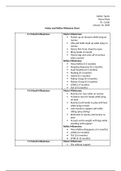main policies that contributed to its success.
Words: 1987
Introduction
In this essay, I explore Singapore’s rapid industrialisation from a labour-intensive economy to a skilled
manufacturing-intensive economy between 1970-1980 via two necessary policies: a looser immigration
policy to attract foreign skilled labour, and a bilingual education policy.
Singapore’s structural change and industrialisation has been impressive, considering its lack of natural
resources and former colonisation by the British Empire (Robinson, 2018). Its real GDP per capita
quintupled over a decade from approximately $900 to $5,000 as real GDP grew at an average rate of 9.2%
between 1970-1980 (Figure 1; SG101 (2023)). The Singapore Department of Statistics estimated that
post-colonial structural change was highest between 1966 and 1975, as Singapore’s economy
transitioned from producing primarily labour-intensive, low-skilled products such as toys and wigs, to
skilled manufacturing goods such as electronic appliances (Wong (1987); Yeo (2016)).
In this essay, Singapore’s structural change has been analysed in a comparable sample of the Asian Tigers
(Singapore, Hong Kong, and South Korea) and the global average, where data was available; Taiwan was
excluded from the sample due to inconsistent data availability.
1
,Figure 1:
Sources: World Bank (2023a); World Bank (2023b); World Bank (2023e); (World Bank, 2023g); (Yeo,
2016).
Looser Immigration Policy for Skilled Workers
Looser immigration policy for highly skilled foreign workers in the late-1960s aimed to achieve both
short- and long-run objectives. In the short run, increasing the ease of immigration for skilled workers to
enter the country and work in high-skilled roles filled the immediate gap of skilled workers required to
build skills-intensive products (Yeo, 2016). In the long run, this allowed knowledge spillovers to accelerate
improvements in human capital as native Singaporeans closed the skills gap (Boberg-Fazlić & Sharp,
2024).
Figure 2 shows the composition of Singapore’s labour force over 50 years. Between 1970 and 1990, both
the populations of non-resident and resident labour increased, accelerating the growth rate of the total
workforce.
2
, Figure 2: Composition of the Singapore Labour Force
Source: Pan and Theseira (2023)
Bahar and Rapoport (2018) argue that a 10% immigration from countries that export a product tends to
lead to a 2% increase in the likelihood that the host country will start to export that product “from
scratch” in the next decade. The non-resident workforce in Singapore grew from 3.2% of the total
workforce in 1970 to 11.1% in 1980 (Pan and Theseira, 2023). Bahar and Rapoport (2018)’s argument is
supported by Figure 3, where Singapore is shown to have transitioned from being a net importer of
electrical machinery and appliances, to becoming a net exporter of them in 1980. In addition to this, by
the late-1980s, wholly foreign firms accounted for less than 20% of all manufacturers (including skilled
manufacturers) but contributed over half of GDP (and two-thirds of direct exports) (Wong, 1987).
Over the long run, it facilitated Singapore’s improvements in human capital, which grew 200% between
1960 and 2018, compared to an average improvement of 105% for the other Asian Tigers (Feenstra,
Inklaar, & Timmer, 2015).
3


